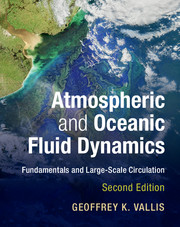3653 results in ebooks in fluid mechanics
Part III - Spray Formation and Impact onto Surfaces
-
- Book:
- Collision Phenomena in Liquids and Solids
- Published online:
- 13 July 2017
- Print publication:
- 15 June 2017, pp 321-322
-
- Chapter
- Export citation
14 - Fragmentation
- from Part V - Solid–Solid Collisions
-
- Book:
- Collision Phenomena in Liquids and Solids
- Published online:
- 13 July 2017
- Print publication:
- 15 June 2017, pp 566-603
-
- Chapter
- Export citation
13 - Shaped-charge (Munroe) Jets and Projectile Penetration
- from Part V - Solid–Solid Collisions
-
- Book:
- Collision Phenomena in Liquids and Solids
- Published online:
- 13 July 2017
- Print publication:
- 15 June 2017, pp 515-565
-
- Chapter
- Export citation

Atmospheric and Oceanic Fluid Dynamics
- Fundamentals and Large-Scale Circulation
-
- Published online:
- 09 June 2017
- Print publication:
- 08 June 2017
12 - Geostrophic Turbulence and Baroclinic Eddies
- from PART II - WAVES, INSTABILITIES AND TURBULENCE
-
- Book:
- Atmospheric and Oceanic Fluid Dynamics
- Published online:
- 09 June 2017
- Print publication:
- 08 June 2017, pp 445-472
-
- Chapter
- Export citation
Notation
-
- Book:
- Atmospheric and Oceanic Fluid Dynamics
- Published online:
- 09 June 2017
- Print publication:
- 08 June 2017, pp xvii-xviii
-
- Chapter
- Export citation
3 - Shallow Water Systems
- from PART I - FUNDAMENTALS OF GEOPHYSICAL FLUID DYNAMICS
-
- Book:
- Atmospheric and Oceanic Fluid Dynamics
- Published online:
- 09 June 2017
- Print publication:
- 08 June 2017, pp 105-142
-
- Chapter
- Export citation
22 - Equatorial Circulation and El Niño
- from PART IV - LARGE-SCALE OCEANIC CIRCULATION
-
- Book:
- Atmospheric and Oceanic Fluid Dynamics
- Published online:
- 09 June 2017
- Print publication:
- 08 June 2017, pp 861-908
-
- Chapter
- Export citation
10 - Waves, Mean-Flows, and their Interaction
- from PART II - WAVES, INSTABILITIES AND TURBULENCE
-
- Book:
- Atmospheric and Oceanic Fluid Dynamics
- Published online:
- 09 June 2017
- Print publication:
- 08 June 2017, pp 379-412
-
- Chapter
- Export citation
8 - Linear Dynamics at Low Latitudes
- from PART II - WAVES, INSTABILITIES AND TURBULENCE
-
- Book:
- Atmospheric and Oceanic Fluid Dynamics
- Published online:
- 09 June 2017
- Print publication:
- 08 June 2017, pp 297-334
-
- Chapter
- Export citation
Contents
-
- Book:
- Atmospheric and Oceanic Fluid Dynamics
- Published online:
- 09 June 2017
- Print publication:
- 08 June 2017, pp vii-xii
-
- Chapter
- Export citation
13 - Turbulent Diffusion and Eddy Transport
- from PART II - WAVES, INSTABILITIES AND TURBULENCE
-
- Book:
- Atmospheric and Oceanic Fluid Dynamics
- Published online:
- 09 June 2017
- Print publication:
- 08 June 2017, pp 473-508
-
- Chapter
- Export citation
2 - Effects of Rotation and Stratification
- from PART I - FUNDAMENTALS OF GEOPHYSICAL FLUID DYNAMICS
-
- Book:
- Atmospheric and Oceanic Fluid Dynamics
- Published online:
- 09 June 2017
- Print publication:
- 08 June 2017, pp 55-104
-
- Chapter
- Export citation
PART I - FUNDAMENTALS OF GEOPHYSICAL FLUID DYNAMICS
-
- Book:
- Atmospheric and Oceanic Fluid Dynamics
- Published online:
- 09 June 2017
- Print publication:
- 08 June 2017, pp 1-2
-
- Chapter
- Export citation
PART II - WAVES, INSTABILITIES AND TURBULENCE
-
- Book:
- Atmospheric and Oceanic Fluid Dynamics
- Published online:
- 09 June 2017
- Print publication:
- 08 June 2017, pp 213-214
-
- Chapter
- Export citation
19 - Wind-Driven Gyres
- from PART IV - LARGE-SCALE OCEANIC CIRCULATION
-
- Book:
- Atmospheric and Oceanic Fluid Dynamics
- Published online:
- 09 June 2017
- Print publication:
- 08 June 2017, pp 731-760
-
- Chapter
- Export citation
1 - Equations of Motion
- from PART I - FUNDAMENTALS OF GEOPHYSICAL FLUID DYNAMICS
-
- Book:
- Atmospheric and Oceanic Fluid Dynamics
- Published online:
- 09 June 2017
- Print publication:
- 08 June 2017, pp 3-54
-
- Chapter
- Export citation
9 - Barotropic and Baroclinic Instability
- from PART II - WAVES, INSTABILITIES AND TURBULENCE
-
- Book:
- Atmospheric and Oceanic Fluid Dynamics
- Published online:
- 09 June 2017
- Print publication:
- 08 June 2017, pp 335-378
-
- Chapter
- Export citation
18 - Water Vapour and the Tropical Atmosphere
- from PART III - LARGE-SCALE ATMOSPHERIC CIRCULATION
-
- Book:
- Atmospheric and Oceanic Fluid Dynamics
- Published online:
- 09 June 2017
- Print publication:
- 08 June 2017, pp 673-728
-
- Chapter
- Export citation
Dedication
-
- Book:
- Atmospheric and Oceanic Fluid Dynamics
- Published online:
- 09 June 2017
- Print publication:
- 08 June 2017, pp v-vi
-
- Chapter
- Export citation
